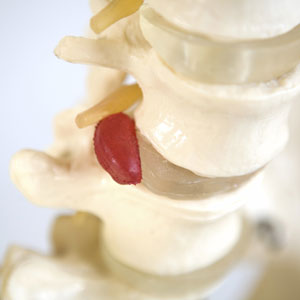 People call it a lot of different things: bulging disc, slipped disc, herniated disc. What is it?
People call it a lot of different things: bulging disc, slipped disc, herniated disc. What is it?
The spinal disc is the padding between each of the bones in your spine (vertebrae). This disc acts as a cushion but is actually a joint allowing your spine to bend and twist. Without your discs, you wouldn’t be able to bend over, twist or rotate.
The disc is a lot like a jelly donut. On the outside is a fibrous wall that acts to support the structure and shape of the disc and gives it the strength to support the spine. This outer wall is called the annulus, or annular fibers. On the inside of the disc is a more gelatinous material (again think of the inside of a jelly donut). This gelatinous interior is called the nucleus palposus. The nucleus palposus allows the disc to compress and take forces acting as a cushion so your spine isn’t injured when undergoing various forces.
Unfortunately, the disc can be injured from traumatic injury like a car accident, sports injury or fall. It can also weaken over time due to bad posture, repetitive motion, desk posture, etc. When the outer fibers of the disc are injured they tear and create a weakness in the outer wall. Eventually, a tear can form and the inner gelatinous material (the nucleus) will push through the wall and bulge outside of the spine.
Imagine what would happen if you squeezed a jelly donut. The inside jelly pushes through the donut.
In the lower back, a bulging disc can cause lower back pain, pain or burning into the buttocks and upper thighs, pain shooting down the leg and into the foot and can even cause numbness, tingling or weakness into one or both legs.
In the neck, a bulging disc can cause terrible neck pain, headache, pain or numbness shooting into the arms and hands, weakness of the arms, and restricted motion in the neck.
We Can Help
At Ritchie Chiropractic & Wellness, we are proud to offer Non-Surgical Spinal Decompression (NSSD). Spinal decompression is a technique that employs the use of a special table that gently distracts the spine, either lower spine or neck, to allow the disc bulge to pull back into the spine and get the pressure off the nerve.
Non-Surgical Spinal Decompression is an effective way at not only alleviating the pain and symptoms of a disc bulge but also to allow the body to heal the disc in an effort to prevent future occurrences. Contact us today to schedule a consultation with our doctor.
